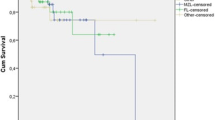Abstract
Objective
To analyze the prognostic factors in patients with non-Hodgkin’s lymphoma (NHL) and to investigate the prognostic value of the absolute lymphocyte count (ALC) in peripheral blood in NHL patients at admission.
Methods
The clinical features and follow-up data from 108 NHL patients whose diagnosis was confirmed through pathologic examination during a period from January 2000 to January 2008 were reviewed. SPSS 14.0 package was used for statistical analysis, and the Kaplan-Meier curve method for assessment of survival probability. Furthermore, the Cox regression model was utilized for multivariate analysis for all parameters which were statistically significant and confirmed by univariate analysis.
Results
In the 108 NHL patients, the male-female ratio was approximately 1.5: 1 and the median age was 48 years. Before treatment, 61.1% of the patients had stage I and II disease, based on the Ann Arbor Clinical Classification. The ECOG performance status (PS) score reached a range from 0 to 1 in about 93% of total patients, and an elevated serum lactate dehydrogenase (LDH) was seen in 19.2%. Based on the international prognostic index (IPI) score, 80.6% of patients were in the low risk group. On admission, 35.2% of patients had an ALC ≤ 1 × 109/L. Anemia, i.e. hemoglobin (Hb) ≤ 110 g/L was seen in 29.6% and B-symptoms in 26.9% of patients. The mean value of Hb was 129.2 ± 17.5 g/L in patients with ALC > 1 × 109/L (n = 70) and 98.1 ± 20.6 g/L in those with ALC ≤ 1 × 109/L (n = 38), and the difference between the 2 groups was statistically significant (P < 0.05). With a median follow-up period of 2 years, the median survival time was 2.3 years among all patients. The 2-year and 5-year overall survival (OS) rates were 73.2% and 39.6%, respectively. It was shown by univariate analysis that ALC ≤ 1 × 109/L, Hb ≤ 110 g/L, B-symptoms, and the IPI ≥ 2 were statistically significant unfavorable prognostic factors in NHL patients. Multivariate analysis revealed that ALC ≤ 1 × 109/L, B-symptoms, and the IPI ≥ 2 were independent unfavorable prognostic factors in NHL patients.
Conclusion
The numerical value of ALC and the presence of B-symptoms are prognostic factors independent of IPI in NHL patients. Clinically, determining prognosis based on the IPI combined with simple clinical parameters, such as the numerical value of ALC and B-symptom status, might be of more practical value in determining individualized treatment regimens for NHL patients.
Similar content being viewed by others
References
Siddiqui M, Ristow K, Markovic SN, et al. Absolute lymphocyte count predicts overall survival in follicular lymphomas. Br J Haematol 2006;134: 596–601.
Kim DH, Baek JH, Chae YS, et al. Absolute lymphocyte counts predict response to chemotherapy and survival in diffuse large B-cell lymphoma. Leukemia 2007; 21: 2227–2230.
Talaulikar D, Choudhury A, Shadbolt B, et al. Lymphocytopenia as a prognostic marker for diffuse large B cell lymphomas. Leukemia & Lymphoma 2008; 49: 959–964.
Ray-Coquard I, Cropet C, Van Glabbeke M, et al. Lymphopenia as a prognostic factor for overall survival in advanced carcinomas, sarcomas, and lymphomas. Cancer Res 2009; 69: 5383–5391.
Hou M, Hao R. Clinical and hematology analysis of bone marrow involvement in NHL. Zhongliu Fangzhi 1994; 3: 15–17 (Chinese).
Duan XL, Jiang M. Analysis of prognostic factors of 92 patients with non-Hodgkin lymphoma. Zhongguo Zhongliu Linchuang 2008; 35: 71–74 (Chinese).
Porrata LF, Markovic SN. Timely reconstitution of immune competence affect clinical outcome following autologous stem cell transplantation. Clin Exp Med 2004; 4: 78–85.
Angulo GD, Yuen C, Palla SL. Absolute Lymphocyte Count Is a Novel Prognostic Indicator in ALL and AML. Cancer 2008; 112: 407–415.
Bierman PJ, Lynch JC, Bociek RG, et al. The International Prognostic Factors Project score for advanced Hodgkin’s disease is useful for predicting outcome of autologous hematopoietic stem cell transplantation. Ann Oncol 2002; 13: 1370–1377.
Behl D, Porrata LF, Markovic SN, et al. Absolute lymphocyte count recovery after induction chemotherapy predicts superior survival in acute myelogenous leukemia. Leukemia 2006; 20: 29–34.
Porrata LF, Gertz MA, Inwards DJ, et al. Early lymphocyte recovery predicts superior survival after autologous hematopoietic stem cell transplantation in multiple myeloma or non-Hodgkin lymphoma. Blood 2001; 98: 579–585.
Author information
Authors and Affiliations
Corresponding author
About this article
Cite this article
Tang, Jm., Chen, Aw., Peng, Wm. et al. Analysis of prognostic factors in 108 patients with non-Hodgkin’s lymphoma. Clin. Oncol. Cancer Res. 7, 44–47 (2010). https://doi.org/10.1007/s11805-010-0044-8
Received:
Accepted:
Published:
Issue Date:
DOI: https://doi.org/10.1007/s11805-010-0044-8




